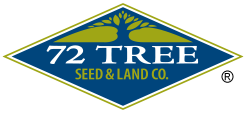Notice: Undefined variable: page in /home/vrxdg1855sn3/public_html/wp-content/themes/72tree/content.php on line 15
Notice: Trying to get property 'ID' of non-object in /home/vrxdg1855sn3/public_html/wp-content/themes/72tree/content.php on line 15
How to Fix Exposed Tree Roots
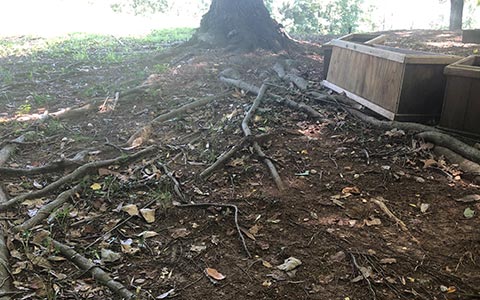
Are ugly surface roots buckling your concrete driveway or stopping you from mowing your lawn? Before you get frustrated and cut them out, there are some things you need to know.
72tree.com gathered the following information on how to handle surface roots without compromising the health of your tree.
Why Do Tree Roots Surface
While some roots grow deep in the ground, the majority of them spread out from the trunk within the first 4 to 12 inches of soil. As the tree ages, several factors may bring them to the surface:
Erosion – Over time, the top layers of soil may be washed away, lowering the ground level, subsequently exposing tree roots.
Soil Compaction – As tree roots spread out, they seek moist aerated soil to derive water and nutrients. When they run into compacted soil, they will turn downward or upward, and in many cases will grow along or just beneath ground level.
Natural Growth – The same way a tree trunk and limbs increase their girth with age, so do roots. Since the majority of tree roots grow within the first few inches of soil, they tend to break the surface as they thicken.
Species – Some trees grow this way. Species such as maples, poplars, and willows tend to grow surface roots.
As annoying as it may be, surface roots are a common landscape problem that can cause significant and costly damage.
Surface Root Problems
When tree roots surface, there are many potential issues they bring with them. Those issues may include:
Disease, Infestation, and Rot – Surface roots are highly susceptible to being injured or damaged by landscaping equipment, foot traffic, or wildlife. Damaged surface roots are easily infected by disease, or infested by insects and can carry harmful pathogens to the trunk and branches of the tree.
Damaged Driveway or Sidewalk – As these roots thicken and surface, the ones that have grown under sidewalks, driveways, and foundations will eventually exert enough pressure to raise or break them.
Read more on how tree roots can buckle a driveway and what to do at 72tree.com/tree-roots-buckling-concrete-driveway/
Damaged Landscape Equipment – Lawnmowers and other mechanical equipment can be severely damaged when making contact with surfaced tree roots.
Abnormal Growth – Where Tree roots surface, any grass or plant life surrounding those roots may become sparse or die.
Trip Hazard – When surface roots are further exposed by erosion, they may become a severe trip hazard when navigating your landscape.
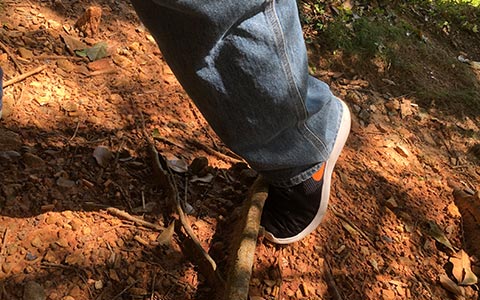
Surface Root Solutions
While cutting the roots away may seem to be the best alternative, it is not. Cutting away roots (like damaging them) leaves the tree highly susceptible to deadly diseases and infestation.
The following are ways to resolve surface root issues without causing severe damage to the tree:
Mulch – At the first sign of roots breaking the surface, lay down a 2 to 3-inch layer of organic mulch. Mulch will help the soil retain moisture, and over time may redirect the roots to grow downward.
Soil Replacement – In cases of erosion exposing roots, lay down a 3 to 4-inch layer of soil to replace what was eroded. To prevent further erosion, you can mulch the area around the tree, seed the new soil with grass, or lay down sod.
Plant Plants – Where erosion is not the problem, one solution may be planting the area with taller ground cover or plants that won’t need mowing. As you create this “tree root garden,” take care to avoid damaging the roots while planting.
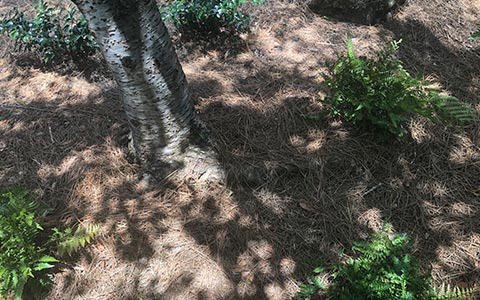
If you are still inclined to have the roots removed, hire an arborist to do this for you. Depending on the damage that may have already occurred, and type of roots that will be removed, it may be suggested to remove the tree.
Surface Root Prevention
Avoid the inconvenience of surface roots by taking action before they come to the surface:
Planting Location – Each tree species has a preferred type of soil, light, and nutrients for healthy growth. By planting trees in optimal conditions for their species, roots will be less likely to surface as the tree ages.
Soil – The soil type, moisture level, nutrient content, and pH level affect how tree roots grow. Deep watering, seasonal fertilizing, and annual pH level adjustments will encourage tree roots to grow deeper.
Species – As mentioned earlier, some tree species are prone to grow surface roots. When selecting trees for your landscape or yard, be sure to ask about the tree’s growth patterns, and do your research on the species needs for optimal growing conditions.
Read more about tree planting and care at 72tree.com/tree-planting-guide/
Exposed Tree Root Solutions
Don’t let gnarly surface roots discourage you from having a beautiful landscape. There are ways to incorporate them in your design without fatally wounding your tree.
In this article, you discovered why tree roots come to the surface, the problems they can cause, and measures you can take to solve and prevent them.
Your mishandling or damaging of surface roots can lead to the health decline and death of your tree. Before you cut roots away, call a professional to evaluate the situation and offer alternatives to save your landscape and your tree.
Sources:
https://extension.umd.edu/hgic/topics/surface-roots
https://www.purdue.edu/hla/sites/yardandgarden/when-tree-roots-surface/
Notice: Undefined variable: page in /home/vrxdg1855sn3/public_html/wp-content/themes/72tree/content.php on line 15
Notice: Trying to get property 'ID' of non-object in /home/vrxdg1855sn3/public_html/wp-content/themes/72tree/content.php on line 15
How is Your Tree Fighting Global Warming
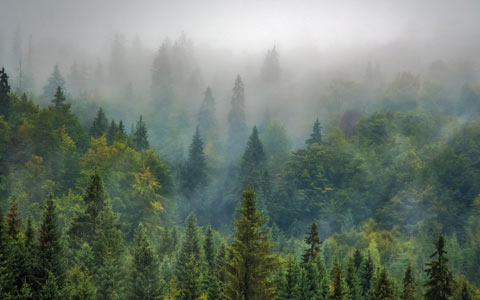
Did you know that your tree is part of a global carbon sequestration system that sustains breathable air for the human race? In fact, without trees, life on earth as we know it would cease to exist.
72tree.com gathered essential information about the role of carbon sinks and how keeping your tree healthy plays a vital role in combating global warming and sustaining breathable air.
What Are Carbon Sinks
A carbon sink is a natural system that absorbs, uses, and stores carbon dioxide from the atmosphere. Technically, you could say that anything that absorbs more carbon than it releases is a carbon sink.
Earth’s principal carbon sinks are:
Trees and Plants – Trees and plants use carbon dioxide captured from the atmosphere for their photosynthesis (food making) process.
Oceans – The oceans play a significant role in storing carbon dioxide. Some marine life will capture the gas for photosynthesis, while some of the gas simply dissolves in the water.
Soil – As plant life dies and decomposes, a portion of its captured carbon dioxide is transferred to the soil.
Nearly a quarter of the carbon dioxide humans have released into the atmosphere has been absorbed by trees and plants. As atmospheric carbon dioxide levels increase, so increases carbon fertilization.
Carbon Fertilization and Tree Growth
As atmospheric carbon dioxide levels increase, more is available to convert to plant matter through photosynthesis, and trees can grow more. This increased growth is referred to as carbon fertilization.
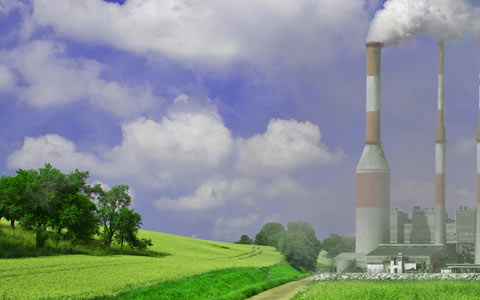
Because of carbon fertilization, trees will continue to grow larger and for more extended periods, as long as their necessity for water, sunlight, and nutrients (primarily nitrogen) is met. If a tree is missing just one of these necessities, it will not grow regardless of the abundance of the others.
Tree Planting and Forest Conservation
Tree planting and forest conservation are vital activities towards the reduction of mankind’s carbon footprint, as trees are remarkably efficient at carbon sequestration, they provide up to 30% of the global action required to stop climate change.
In fact, a single healthy tree is capable of releasing around 6,000 pounds of breathable oxygen over 50 years. That’s about the oxygen consumption of 4 people per year.
With 3.04 trillion trees worldwide and a world population of 7.53 billion, trees alone produce approximately 4,845 pounds of oxygen per person per year. While this number seems reasonably sufficient, carbon emissions are on the rise around the globe, leaving the ominous question of “How long can our trees sustain our oxygen requirements?”
Along with rising carbon emissions, trees and forests, do not always act as carbon sinks. In fact, massive carbon releases by trees may occur at any time when triggered by:
• Deforestation
• Tree and plant decay
• Forest fires
• Wildfires
• Volcanic eruptions
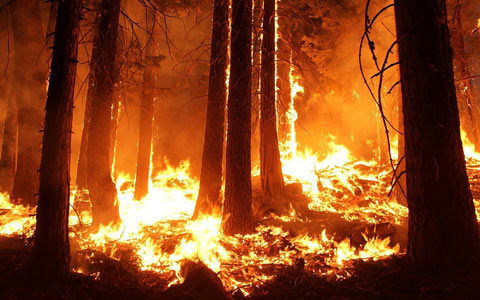
Suffice it to say that as long as carbon emissions continue rising, and the global tree population is threatened, the delicate balance of carbon sequestration and oxygen production can easily slide in the wrong direction.
Tree and forest conservation is one of our best weapons to fight global warming, and it starts in your yard. Keep your trees healthy by making sure they:
• Are planted in the right place
• Have the best soil type for the species
• Have sufficient water
• Are fertilized before their growth period
• Are seasonally pruned
• Are properly mulched
• Inspected annually for disease and infestation
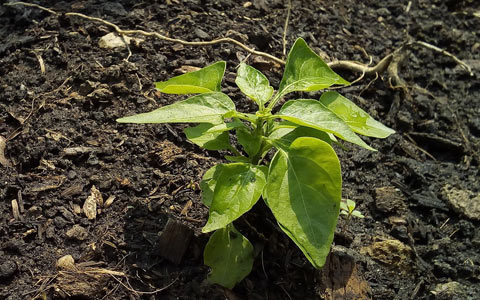
Learn more about planting trees at 72tree.com/tree-planting-guide/
When living near or visiting a forest, you can participate in its conservation by:
• Camping in only designated areas
• Removing or disposing of your trash properly
• Building fires in designated fire-pits
• Fully extinguishing fires before leaving
• Disposing of matches and cigarette butts properly
• Not discharging fireworks
• Reporting suspicious activities
• Notifying park rangers of dead or dying trees
• Avoiding all activities that can physically harm trees
Learn more about forest conservation and preventing wildfires at redcross.org/get-help/how-to-prepare-for-emergencies/types-of-emergencies/wildfire/how-to-prevent-wildfires.html
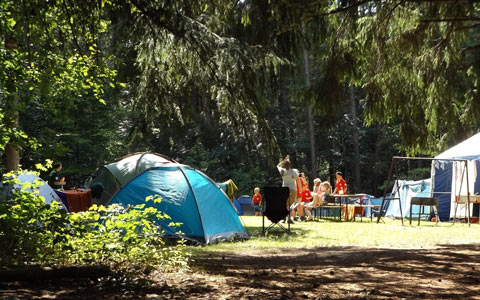
Your Tree, Climate Change, and Global Warming
It may be hard to imagine, but by keeping your trees healthy, you are actively pushing back against climate change and global warming. The human race owes its breathable air to the global population of trees, as they sequester carbon dioxide and release the oxygen we breathe.
In this article, you discovered the function and importance of carbon sinks, how your tree plays a significant role in global oxygen production, and how healthy trees and forests help to stop climate change and reverse global warming.
By keeping your trees healthy, you are actively participating in the reduction of atmospheric carbon dioxide, thus slowing climate change and global warming.
Sources:
https://earthobservatory.nasa.gov/features/CarbonCycle/page5.php
https://www.americanforests.org/blog/forests-carbon-sinks/
https://www.nasa.gov/feature/goddard/2016/carbon-dioxide-fertilization-greening-earth
https://www.conservation.org/stories/Pages/14-forest-conservation-facts-you-need-to-know.aspx
https://www.npr.org/2015/12/26/461095807/tree-counter-is-astonished-by-how-many-trees-there-are
Notice: Undefined variable: page in /home/vrxdg1855sn3/public_html/wp-content/themes/72tree/content.php on line 15
Notice: Trying to get property 'ID' of non-object in /home/vrxdg1855sn3/public_html/wp-content/themes/72tree/content.php on line 15
The Stunning Southern Magnolia Tree and its Flower
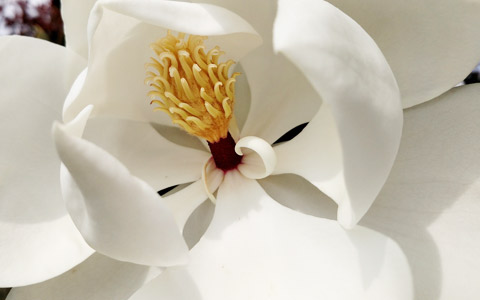
The Southern magnolia (Magnolia grandiflora) is an essential tree for yards and landscapes in hardiness zones 6 through 10, for its size, year-round beauty, and its enormous creamy white flowers.
72tree.com gathered essential information on the Southern magnolia tree, its characteristics, incredible flowers and their blooming season.
Magnolia Tree Information
Magnolia grandiflora, with its full luxurious look, is a favorite specimen around the world. The following are some of its features:
Family – Magnoliaceae
Height – 50 to 80 feet at maturity with some reaching 90 feet.
Width – The base of a fully mature magnolia can reach 40 feet in diameter.
Foliage – Mature leaves are dark glossy green and densely grow up to 8 inches in length by 5 inches wide.
DBH – The diameter at breast height of a fully mature magnolia tree can reach 24 to 36 inches.
Crown Width – This species grows in a pyramidal shape, its mid and lower sections can reach a diameter of 30 to 40 feet and tapers upward to a pointed or rounded crown.
Leaf Drop – While Magnolia grandiflora is an evergreen species, it will drop light foliage throughout the year.
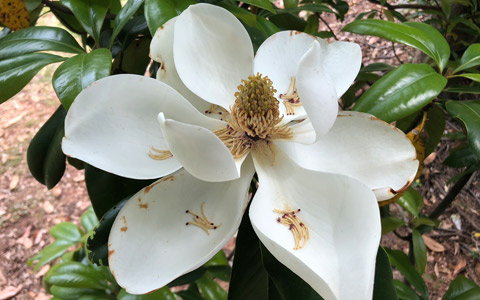
Blooms – The flowers of Magnolia grandiflora are creamy white and can reach up to 12 inches in diameter.
Pests – While magnolia trees are generally free of significant pest problems, some varieties of scale, aphids, mealybugs, spider mites, and leafminers present potential infestations.
Disease – There are several fungi which can cause leaf spots, and in some cases, may lead to heart rot. However, for the most part, fungi are unable to cause any significant damage to adult magnolias. In the event of severe leaf drop or branch dieback, an arborist should be called to evaluate the situation and recommend a course of action.
This magnificent species, native to the southeastern United States, has been planted in cities all over the world. It’s no wonder that Magnolia grandiflora became an instant hit when it was taken to Europe in the 1700s.
Due to its adaptability to many climates and soil types, and its unique beauty, this species has become one of the most widely planted ornamental evergreen trees in the world.
To learn more about the USDA Hardiness Zone Map, read Trees, Shrubs, and the USDA Hardiness Zone Map at 72tree.com/trees-shrubs-usda-hardiness-zone-map/
Magnolia Tree Flower
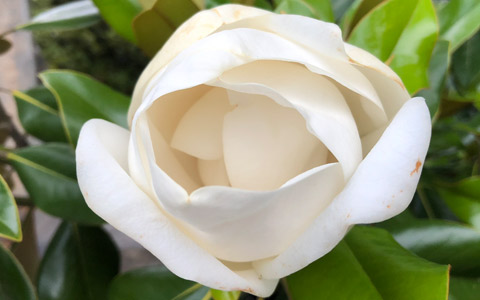
The majestic Southern magnolia tree has an incredibly dominating presence from mid-summer through the end of winter. However, in early to mid spring, this specimen displays its true glory and reason for its worldwide admiration.
When the Southern magnolia blooms, it blooms at the tips of twigs all over with dozens of white lemon citronella-scented flowers open at a time. Healthy mature magnolias bloom consecutively until mid-summer, and these enormous flowers range in size, reaching up to 12 inches in diameter and lasting up to 7 days from bloom to wilt.
The Magnoliaceae family is among the eldest of tree families in existence. Due to this, we get to witness two pre-evolutionary aspects of flowers:
Tepals, not Petals – In magnolia flowers, the petals are fused with the sepals (sepals are typically green and function as protection for the flower while in bud); therefore, the correct terminology for these parts is tepals. The tepals of the magnolia flower are usually arranged in two whorls of 3 to 6 tepals each.
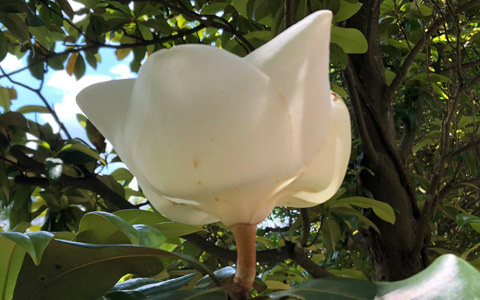
No Nectar Here – That’s correct, magnolia flowers do not produce nectar. These flowers attract pollinating beetles with their fragrant and sugary secretions.
The beautiful magnolia flower is the state flower of Mississippi and Louisiana, while the tree itself is the state tree of Mississippi. It should come as no surprise that the largest Southern magnolia is located in Smith County, Mississippi, measuring more than 122 feet tall with a DBH greater than 6 feet.
The Flowering Magnolia Grandiflora
If you live in the South and your landscape doesn’t include a Southern Magnolia, you’re missing out on one of the oldest and most beautiful blooming evergreen trees in existence.
In this article, you discovered a wealth of information about the Southern magnolia tree and its beautiful flowers.
If your property lies within hardiness zones 6 through 10, and you have yet to plant a magnolia tree, you should consider doing so for the beauty of the tree and the elegance of its sensational flowers.
Sources:
https://plants.ces.ncsu.edu/plants/all/magnolia-grandiflora/
https://hgic.clemson.edu/factsheet/magnolia/
https://www.arborday.org/trees/treeguide/TreeDetail.cfm?ItemID=863
https://edis.ifas.ufl.edu/st371
Notice: Undefined variable: page in /home/vrxdg1855sn3/public_html/wp-content/themes/72tree/content.php on line 15
Notice: Trying to get property 'ID' of non-object in /home/vrxdg1855sn3/public_html/wp-content/themes/72tree/content.php on line 15
Oak Wilt Identification, Treatment, and Prevention
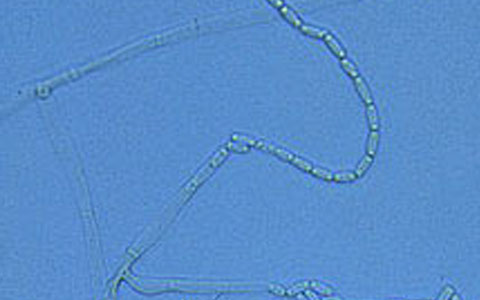
Don’t let oak wilt (Bretziella fagacearum) kill your tree. While few fungi can bring down the mighty oak tree, this is one of them.
Oak wilt is one of the most destructive tree diseases in the United States, and it’s on the loose, killing oak trees at nearly epidemic proportions. If your oak tree(s) appear to be in trouble, its problems may be caused by a fungus that, if not halted, will kill your tree in a matter of months.
72tree.com gathered essential information about oak wilt disease, how to identify it, treat it, and prevent it.
What is Oak Wilt?
Bretziella fagacearum, formerly known as Ceratocytis fagacearum, is the scientific name for oak wilt, and this fungal disease affects all species of the oak (Quercus) genus by disabling the water conducting system in these trees.
Based upon porosity and leaf shape, oaks are divided into two groups; red oaks and white oaks. Bretziella fagacearum affects these two groups differently:
White Oak Group – The species below that are part of this group have rounded leaf edges and pores clogged by tyloses.
• Quercus alba (the most commonly known white oak species)
• Quercus lobata (California white oak or valley oak)
• Quercus polymorpha (Mexican white oak or Monterrey oak)
• Quercus bicolor (swamp white oak)
• Quercus arizonica (Arizona white oak)
• Quercus garryana (Oregon white oak or Garry oak)
Tyloses are outgrowths on cells of xylem vessels. Tyloses fall from the sides of the cells and seal a tree’s vascular tissue to prevent or reduce damage.
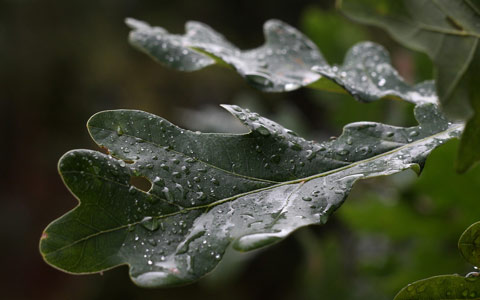
Red Oak Group – The species below that are part of this group have pointed leaf edges and large open pores:
• Quercus falcata (southern red oak)
• Quercus graciliformis (Canby oak or Chisos oak)
• Quercus buckleyi (Texas red oak)
• Quercus rubra (the northern red oak)
• Carnarvonia araliifolia (an Australian rainforest tree)
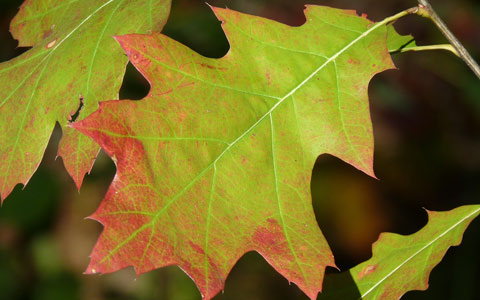
Due to the difference in porosity, species in the red oak group are more easily infected by oak wilt and die more quickly than the white oak group species. In fact, infected trees in the red oak group may die off within a single summer season, where those in the white oak group can persist for several years after being infected.
Another difference is that trees in the red oak group produce fungal spore mats that facilitate the “above ground or overland” spread of the pathogen, whereas the trees in the white oak group rarely produce them.
How to Identify Oak Wilt Disease
Oak trees infected with oak wilt present the following symptoms:
• Leaf chlorosis
• Leaf drop (off-season)
• Dieback from the top down
• Veinal necrosis (Live oak species only)
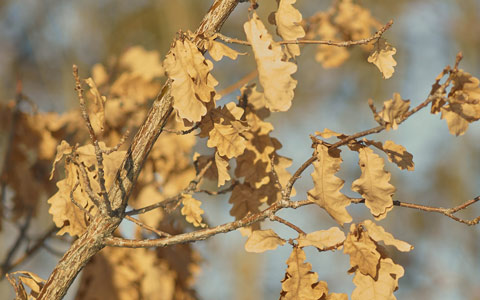
In most cases of infection, oak leaves will turn pale green and then brown while still attached to the tree. By the time they fall, the tree is likely dead.
This disease is dangerous in that it is extremely fast acting; it can kill a mature oak tree in a matter of two to four months while spreading from tree to tree via grafted roots.
Grafted roots occur when the roots of two or more compatible tree species meet and fuse together. Once roots are grafted, they gain the ability to interchange nutrients, water, and disease to each other.
If you suspect that your oak tree is infected with oak wilt, have your tree inspected by an arborist immediately.
How to Treat Oak Wilt Disease
Once Bretziella fagacearum has infected your tree, your fast action is required to halt this pathogen. There are two principle ways to treat oak wilt disease:
Fungicide Treatment – Propiconazole applications are an effective preventative measure. During the earliest stages of infection, this fungicide is injected through holes drilled in the root flare, to the tree’s water-conducting vascular system.
The success of this treatment is greatly influenced by the health of the tree and the fungicide application rate. Any time holes are drilled into a tree for this type of treatment, a professional should be hired to make sure the fungicide is applied correctly and that the holes do not become sources of further infection or infestation.
Trenching to Sever Root Connections – When a tree has been infected and fungicide treatments are no longer viable, trenching will help stop the pathogen from being transmitted from tree to tree by grafted roots.
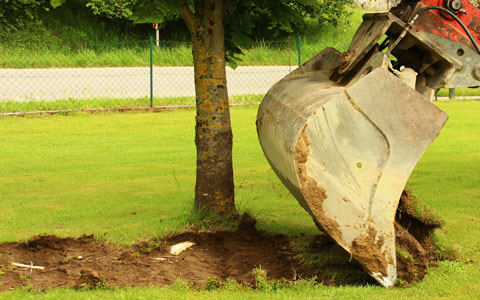
After identifying infected trees, a trench should be dug with a trenching machine, ripper bar, rock saw, or walk-behind trencher to a depth of at least 4 feet (trenches deeper than 4 feet may be required in deeper soil), and a minimum 100 foot radius around the infected tree(s).
Healthy trees within the trench are considered high risk and should be uprooted or removed to improve the effectiveness of the barrier. Tree removal should start immediately after trenching, beginning with the trees closest to the trench, and working inward thereafter until all of the trees within the trench have been eliminated.
An oak wilt contamination can be more easily contained when treatment begins early. Trees outside the trenched area should be monitored for several years after the infected area has been treated, and in the event of further infection, the same procedure (trenching and tree removal) should be repeated while the contaminated area is still manageable.
Oak Wilt Disease Prevention
Tree disease prevention begins with tree health. However, when it comes to oak wilt disease, special care must be taken to avoid infecting otherwise healthy trees. The following will help you avoid spreading the Bretziella fagacearum pathogen to your oaks:
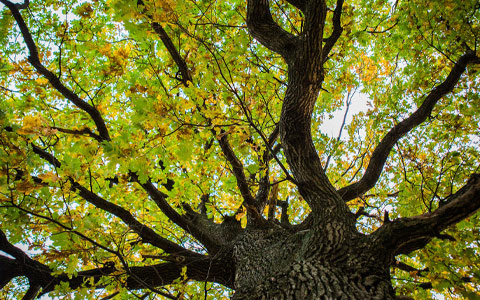
Tree Health – A healthy tree has defense mechanisms that help it stave off attacks from fungi and insect infestation. Whether it be exuding sap to close wounds made by insects, or compartmentalization to contain invading pathogens, the healthier your tree is, the more effective its defense will be. The following steps help you increase your tree’s vitality:
During prolonged dry seasons:
• Provide weekly deep waterings for your trees.
• Fertilize your trees before the growing season begins (February, and early March).
• Mulch your trees to avoid losing soil moisture.
• Inspect your trees frequently for wounds and weather damage (including surface roots), use tree wound dressing, wax based dressing, or latex paint to seal these wounds.
Pruning Activities – Pruning encourages new growth. However, in the case of oak trees, pruning them may provide an opportunity for Bretziella fagacearum to invade and kill your tree. Adhere to the following guidelines when pruning oak trees:
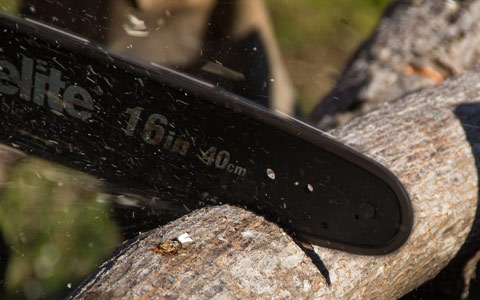
• From February through July, avoid pruning or wounding your oak tree(s). This period is when oak wilt fungal mats are most easily formed, and oak bark beetles (Scolytinae) and sap beetles (nitidulid) are most active.
• Pruning activities should take place during midwinter or extended periods of hot weather in late summer. (these are the periods which present the least threat to your oaks)
• Sterilize all pruning equipment between trees.
• Paint all pruning wounds with a tree wound dressing, wax-based dressing, or latex paint to create an immediate barrier to contaminated beetles or airborne pathogens, regardless of the time of year.
• Freshly cut stumps and wounded surface roots should be dressed immediately, as Bretziella fagacearum can be transmitted from tree to tree through grafted roots.
Diseased Tree Removal – Oak trees that are dead or dying from oak wilt disease should be removed and immediately burned or buried to prevent dissemination of the disease’s spores.
When dealing with infected trees, call on a professional tree service to handle the removal and destruction of these trees. They will also be able to assess the potential risk to surrounding trees and advise you on any further necessary preventative measures.
Firewood Awareness – Avoid purchasing or transporting unseasoned firewood. Since fungal mats may form on unseasoned oak firewood, you could be unintentionally spreading the pathogen to uninfected areas.
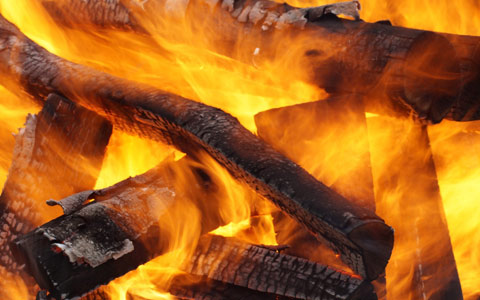
Seasoned firewood has been dried for a minimum of one year and poses little to no threat of spreading the oak wilt pathogen.
Oak Tree Disease – Bretziella Fagacearum
Your mighty oak tree can become infected and die in a matter of months. The Bretziella fagacearum fungus can spread by way of insects, airborne spores, and through grafted roots. By the time you identify the problem, you may be dealing with several infected trees on a fast-track to death.
In this article, you discovered vital information about oak wilt disease, how you can identify it, what you need to do to treat it, and prevention tips.
Your slow response to this fast-acting disease can not only result in the death of your tree, but also to the spread of oak wilt to numerous trees in surrounding environments. At the first sign of trouble, call a professional to help you assess the damage and required measures for containment.
Sources:
https://tfsweb.tamu.edu/OakWiltFAQS/
http://www.inspection.gc.ca/plants/plant-pests-invasive-species/diseases/oak-wilt/fact-sheet/eng/1325629194844/1325632464641
https://www.annualreviews.org/doi/abs/10.1146/annurev.en.07.010162.001551?journalCode=ento
https://www.canr.msu.edu/news/oak_wilt_disease_1
http://www.austintexas.gov/blog/oak-wilt-101
Notice: Undefined variable: page in /home/vrxdg1855sn3/public_html/wp-content/themes/72tree/content.php on line 15
Notice: Trying to get property 'ID' of non-object in /home/vrxdg1855sn3/public_html/wp-content/themes/72tree/content.php on line 15
3 Flowering Trees for Your Alpharetta and Roswell Yard
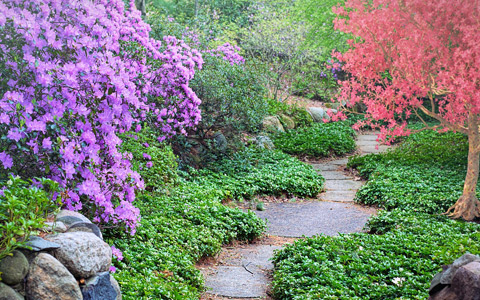
Don’t accept a dull and monochromatic yard. Trees are awakening from their winter slumber and certain species will put on a stunning show of vibrancy and color.
Located in USDA hardiness zone 7b, Alpharetta, Ga is the perfect location for some of the most beautiful flowering trees the South has to offer. If your Alpharetta or Roswell yard doesn’t have one of these trees, you are missing out.
72tree.com gathered care and technical information for flowering dogwood, eastern redbud, and Carolina silverbell blooming tree species perfect for hardiness zone 7b.
Flowering Trees in Alpharetta
The following species are well adapted to the climatic conditions found in Roswell and Alpharetta, Ga. Before choosing a location and breaking ground, read this tree planting guide 72tree.com/tree-planting-guide/
Flowering Dogwood – Cornus Florida is a beautiful tree native to northeastern America, it is hardy in Zones 5 through 9 and flourishes as far west as Texas.
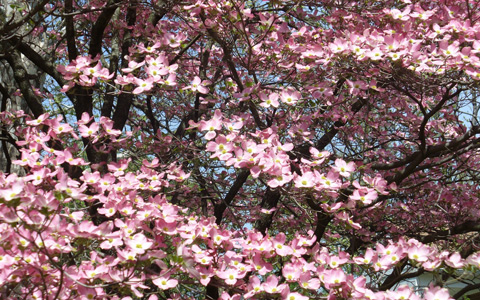
Mature specimens can reach heights of 30 to 35 feet with a crown wider than it is tall. This specimen is considered to be an understory tree with a year-round appeal as it flowers in the spring, maintains attractive foliage throughout summer and fall, and even has an appealing winter appearance.
• Flowering period is April through May with flowers lasting 10 to 15 days.
• Colors include white or pink flowers in spring, bright red fruit in late summer and fall, and light green (spring) dark green (summer) or reddish-purple (fall) foliage.
• Soil should be acidic and well-drained with considerable amounts of organic material.
• Mulch regularly to maintain cool, moist soil.
• Pruning activities should occur either in early or late winter while the tree is in a state of dormancy.
• Susceptible to boring insects, leaf spot, and anthracnose.
When a flowering dogwood must have 25%, or more of its crown pruned to remove an infestation or signs of disease, a certified arborist should be called to evaluate the tree and suggest the best course of action.
Eastern Redbud – Cercis canadensis is noted for being one of the first tree species to flower in the spring. Also native to northeastern America, like the flowering dogwood, it is hardy in Zones 5 through 9 and flourishes as far west as the lower great plains and Texas.
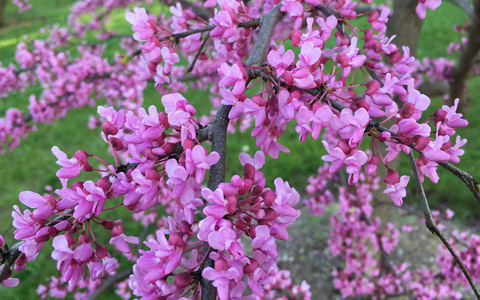
At maturity, the Eastern Redbud reaches heights of 15 to 30 feet with a crown that spreads 25 to 30 feet in diameter. Considered an understory tree, this deciduous specimen provides an incredible show when in bloom.
• Flowering period is March through May before leaf growth. Flowers bloom over the entire crown, creating a “tree of flowers.”
• Colors include pink to reddish-purple flowers, giving way to dark green heart-shaped foliage in late spring.
• Soil should be neutral to slightly alkaline and well-drained for best-growing conditions.
• Pruning activities should occur either in early or late winter while the tree is in a state of dormancy. Pruning helps to strengthen the tree’s structure and promotes its overall health.
• Susceptible to boring insects, redbud leaffolders, grape leaffolder, Japanese weevil, verticillium wilt, Botryosphaeria canker, and leaf anthracnose.
Wildlife tends to leave the Eastern Redbud as a last resort or emergency food source. The tree is fire tolerant, and roots typically sprout after a wildfire or fire-related disturbance.
Carolina Silverbell – Halesia carolina is a flowering understory tree which flourishes in Zones 4 through 8 and is popular for its clusters of white bell-shaped flowers
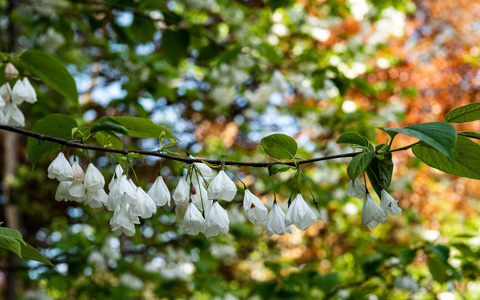
This species reaches a mature height of 30 to 40 feet with its crown reaching up to 35 feet in diameter, and has a rounded or vase-shape.
• Flowering period is April through May with flowers best observed from below as they hang from pendulous stalks in clusters of 2 to 5.
• Colors include white and sometimes rose flowers in spring, green fruit in late summer turning light-brown in fall, and dark green foliage that turns yellow before falling in autumn.
• Soil should be acidic and well-drained with considerable amounts of organic material.
• This species flourishes when grown in light shade and a protected environment.
• Pruning activities should occur either in early or late winter while the tree is in a state of dormancy.
• Susceptible to tree scale when stressed. Healthy Carolina silverbells are otherwise pest-resistant.
Your Carolina silverbell should flourish with minimal seasonal maintenance. However, in the event of drought or changes in the soil pH, the tree may become stressed and appear to droop or wilt. In these cases, call a certified arborist to evaluate the tree, environment, and soil to suggest the best course of action.
After you select some flowering trees for your yard, visit 72tree.com/3-evergreen-species-alpharetta-roswell-yard/ for some perfect evergreens species, 72tree.com/5-popular-alpharetta-ga-shade-trees/ if you need to add some shade to your yard, or 72tree.com/4-shrub-species-alpharetta-georgia-yard/ for the perfect shrubs that can balance your landscape out.
Southern Blooming Trees
As you drive through the streets this spring, you can marvel at some of the most beautiful flowering trees in the South!
In this article, you discovered important information about the beautiful flowering dogwood, eastern redbud, and Carolina silverbell tree species.
Without one of these flowering trees in your yard, you are passing up the opportunity to provide curb appeal and make your yard captivating.
Sources:
https://plants.usda.gov
https://www.wildflower.org/plants/result.php?id_plant=ceca4
http://www.uky.edu/hort/Flowering-Dogwood
http://www.uky.edu/hort/Carolina-Silverbell
Notice: Undefined variable: page in /home/vrxdg1855sn3/public_html/wp-content/themes/72tree/content.php on line 15
Notice: Trying to get property 'ID' of non-object in /home/vrxdg1855sn3/public_html/wp-content/themes/72tree/content.php on line 15
Tree Planting Guide
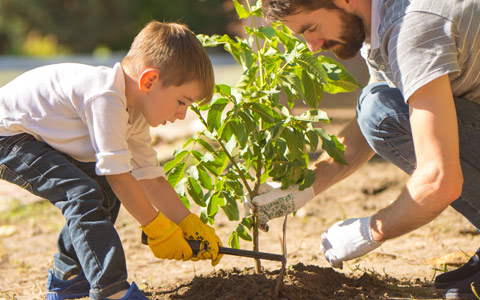
If you could make a significant contribution to the slowing of climate change and global warming, would you do it? With every tree you plant, you increase breathable air, reduce atmospheric CO2, and help the local ecosystem.
Planting a tree is the beginning of a journey with nature. The better the conditions are when planting a tree, the healthier it will be and faster it will grow.
72tree.com gathered the following hardiness zone, location, soil, watering, pruning, and care information to serve as a guide when planting a tree.
Tree Planting – Hardiness Zone
Tree species across the world have adapted to thrive in their respective environment. In the United States, the USDA has determined 11 hardiness zones by their average annual extreme low temperatures.
Before choosing a species to plant, you must first determine which hardiness zone the planting location is in. The following is the USDA’s Hardiness Zone Map.
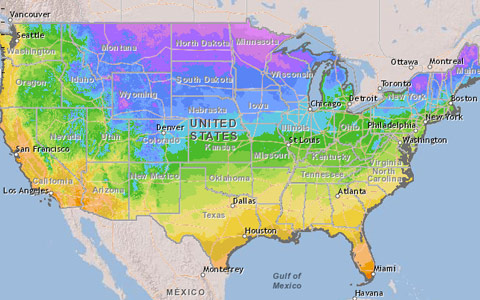
For an interactive version of the map, visit planthardiness.ars.usda.gov/phzmweb/interactivemap.aspx
As an example, the state of Georgia spans through hardiness zones 6b through 8b, making it suitable for maples, oaks, and poplars among others. For these and other shade trees suitable to plant in Alpharetta or Roswell Ga, visit 72tree.com/5-popular-alpharetta-ga-shade-trees/
Once you have determined the hardiness zone of the planting location, it’s time to consider the planting location and select a tree species.
Tree Planting – Location
While trees are impacted largely by climate, conditions within their immediate environment are equally as important. Take the following factors into consideration when choosing which species and where to plant:
Shade Tolerance – Each tree species may react differently to the amount of sunlight it is subjected to daily. Here are the shade tolerance categories:
• Shade Tolerant
• Intermediate Shade Tolerant
• Shade Intolerant
It is important to note that shade intolerant trees like poplars, eucalyptus, aspen, and pecan trees may self-prune (drop entire branches) if subject to partial or full shade environments.
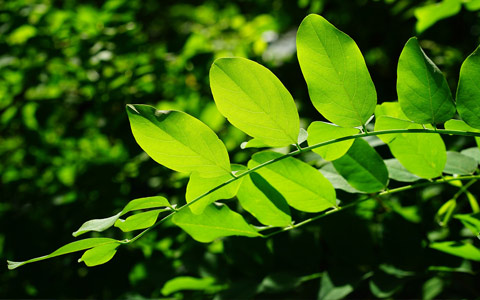
Wind Resistance – High winds and severe weather will test a tree’s foothold and its elasticity. Planting trees around the following wind-blocking features may help them survive the strongest of winds:
• Fences
• Shrubs
• Raised Garden Beds
• Hills
• Sheds
• Buildings
A tree’s resistance to severe weather is also determined by its overall health and seasonal pruning practices. Crown thinning is the perfect example of a pruning technique that allows wind to blow more freely through the crown, significantly reducing the potential for severe damage.
Understory Trees – These trees grow from 20 to 25ft tall and are shade tolerant. These trees are well suited for “plaza” settings or environments in which they are surrounded by buildings and a mostly shaded setting. In a forest, these are the trees that grow between the forest floor and the bottom of the overstory canopy.
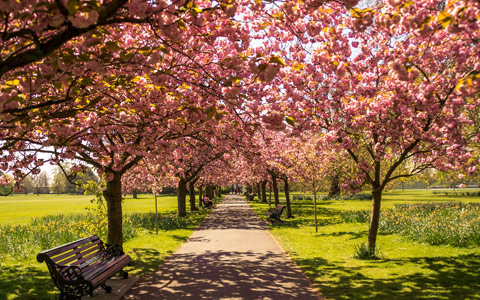
Overstory Trees – These trees grow from 40ft and beyond. Overstory trees are shade intolerant and require wide open space to reach their maximum height potential. In a forest, these are the trees that make up the uppermost part of the canopy.
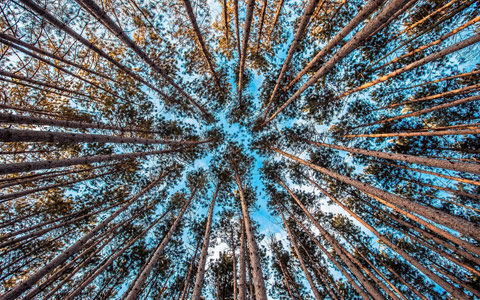
Root Growth – In nearly all tree species, some roots grow deep into the ground to stabilize the tree, and the vast majority of roots spread out around the tree within the top 2 to 3ft of soil in search of water and nutrients.
It is essential that your planting location be far enough away from sidewalks, pathways, driveways, and building foundations to avoid buckling and structural damage.
For more information on how tree roots affect surrounding structures, read 72tree.com/tree-roots-buckling-concrete-driveway/
Tree Planting – Soil
Since soil contains the organic matter and water a tree needs, it is obvious that the growth and health of your new tree depend heavily on the soil it is planted in. The following guidelines will help you prepare the soil for planting:
Soil Type – There are four basic types of soil:
• Sand – Sandy soil has difficulty retaining water and roots are often unable to establish themselves firmly.
• Silt – Silt is a granular quartz or feldspar material sized between sand and clay.
• Clay – Clay soil is the denser of the soil types, has poor drainage, and compacts very easily.
• Loam – Loam is a combination of the other three soil types and is widely considered to be the best soil for planting.
The majority of tree species flourish in well-drained silt or loam soil, while few are adapted to sand or clay soils.
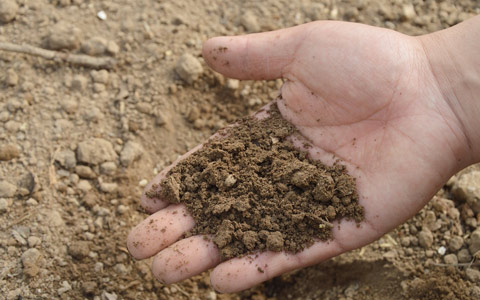
Soil pH Level – Neutral soils have a pH level of 6.5 to 7.5, acidic soils have a pH level below 6.5, and basic soils have a pH level higher than 7.5.
Depending on the species of your tree, it may grow better in acidic soil like pine trees, while most hardwoods do better in slightly acidic to neutral soil.
The pH level of the soil can be lowered by mixing in sulfur, and most fertilizers, while lime or organic mulch, can be added to raise the pH level.
When planting a tree, the soil within a 4 to 5ft radius around the trunk should have its pH adjusted to meet the needs of the tree species, and the soil mixed to a loam consistency to offer the best root development environment.
Tree Planting – Watering
For the first few years of growth, newly planted trees (in well-drained soil) require a deep watering every two weeks or so. Deep watering is when you allow a slow but steady stream of water to penetrate 10in or more into the soil.
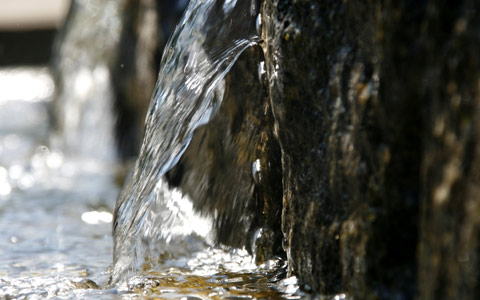
The benefit of deep watering is that roots will grow deeper into the soil, discouraging surface roots. Surface roots are easily damaged, allowing for either infection or infestation which weaken the tree’s health and could lead to its early death.
During rainy seasons, deep waterings should be spread further apart, every 3 to 4 weeks, and during dry seasons or times of drought, weekly deep waterings may be necessary.
Tree Care After Planting
After a full year of growth, it’s time to start applying routine tree care practices. In late fall, you can prune your tree to encourage spring growth, maintain its shape, or remove diseased or damaged limbs. Learn the various tree pruning techniques and their purpose so you avoid making an irreparable mistake.
Fertilizing should only occur between the beginning of spring and the beginning of summer. Fertilizing in mid or late summer will encourage new growth which will not have sufficient time to harden and will likely die in the winter months.
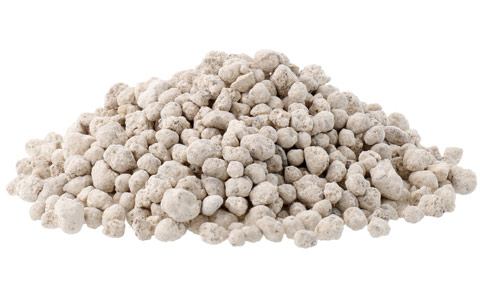
Set up an annual inspection with an ISA certified arborist. An arborist can give you valuable insight as to the influence your landscape has on your tree and vice-versa. He or she can also help in the early detection of disease, infestations, and other potential threats to your tree.
Tree Planting for a Better World
You can help slow the effects of climate change and global warming by planting a tree. With a world population of nearly 8 billion people, research shows that the 3 trillion trees currently occupying the planet with us just won’t be enough for human life to flourish in the coming centuries.
In this article, you discovered the USDA’s Hardiness Zone Map, tree planting guidelines for location selection, soil composition, watering frequencies, pruning, and care.
By neglecting the world’s diminishing tree population, we as a people are potentially condemning future generations to an inhospitable planet in which little – if any – life will be able to survive. When you plant and care for a tree, you are truly helping to save the planet and the future of mankind.
Sources:
http://www.americaslongleaf.org/media/2516/soil-ph-tree-suitability-in-the-south-_sref_.pdf
https://extension.psu.edu/forest-landowners-guide-to-tree-planting-success
https://csfs.colostate.edu/colorado-trees/selecting-planting-and-caring-for-trees/planting-tips/
https://forestry.usu.edu/trees-cities-towns/urban-forestry/landscape-trees-climate
https://www.extension.iastate.edu/forestry/publications/pdf_files/ctspsoilstrees.pdf
Notice: Undefined variable: page in /home/vrxdg1855sn3/public_html/wp-content/themes/72tree/content.php on line 15
Notice: Trying to get property 'ID' of non-object in /home/vrxdg1855sn3/public_html/wp-content/themes/72tree/content.php on line 15
Can We Live Without Trees and How to Save Them
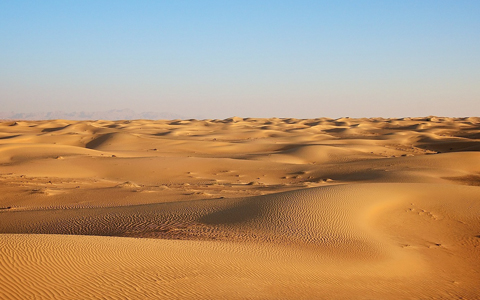
Without trees, we all die. Besides providing oxygen for us to breathe, trees make life on earth sustainable. Discover what is happening to the world’s trees and why we urgently need to stop senseless deforestation.
Trees affect everything from the air we breathe to the rain that falls from the sky. Without a robust population of trees, we die and so does our planet.
72tree.com gathered tree information, statistics, problems, and actions we can all take to preserve our trees and our habitable planet.
What Will Happen if We Cut Down All the Trees?
Right now, just over 3 trillion trees are growing on our planet. Every year, over 15 billion of those trees are felled or lost to natural disasters. At this rate, earth’s last tree will fall in roughly 200 years.
As earth’s tree population nears zero, the following will occur:
Oxygen and CO2 – Trees remove CO2 from the atmosphere and convert it to oxygen through the process of photosynthesis. Without them converting CO2 to oxygen, CO2 levels would begin to rise while oxygen levels would steadily fall.
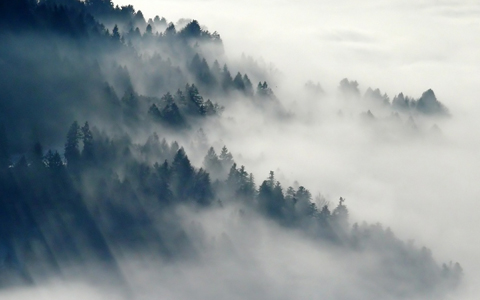
Trees are responsible for 35% of the oxygen we breathe. The other 65% are produced by algae and phytoplankton in the oceans.
Flooding and Erosion – Without tree roots to absorb water and stabilize the soil, even the smallest of storms will result in significant flooding, topsoil erosion, and landslides.
Air and Soil Pollutants – Trees work nonstop to filter ammonia, sulfur dioxide, nitrogen dioxide, and carbon monoxide from the air and soil.
Without trees, these pollutants would find their way into what crops are left and into the feed of what animals are left, not to mention the air we breathe.
Evapotranspiration – Without trees, the process of evapotranspiration would stop. This is the process of moistening the air which produces more clouds. Evapotranspiration is responsible for maintaining the delicate balance between fertile land and dry desolate desert.
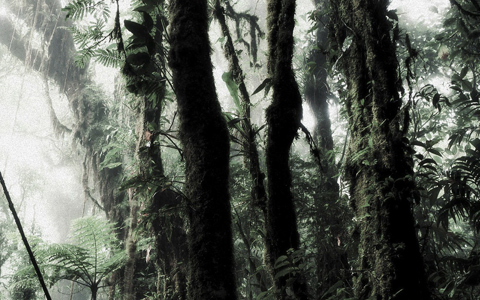
Fewer clouds mean less rain. With less rainfall, fertile land would dry up, fresh water sources would run out or stagnate, and agriculture will begin to fail on a global scale.
Acid Rain – Without trees to remove pollutants, what little rainfall remains would be mostly acidic. All remaining plant life would be crippled.
Global Warming – As the earth’s temperatures rise, the polar ice-caps would melt at an accelerated rate, causing ocean levels to rise and inundate coastal lands and freshwater sources.
As witnessed primarily in the south pole, the ice caps are already receding at an alarming pace, and if this melting isn’t slowed or stopped, it could threaten the survival of all wildlife within that ecosystem.
As the ice melts and causes desalinization in the oceans, weather patterns are subject to erratic change. Off-season snow storms, tsunamis, typhoons, hurricanes, and even blistering summers can all be driven by our raising global thermostat.

Labored Breathing – With CO2 levels on the rise and oxygen levels depleted, people with respiratory and blood problems would be the first to die along with animals unable to cope with the atmospheric changes.
Extinction – Small animals which once depended on trees for food and shelter would be the first to perish. Within a short period, the natural food chain would begin to lose its structure, leaving carnivorous scavengers to likely last the longest.
As temperatures continue to rise, the oxygen levels in the atmosphere decrease, and food sources become even more scarce, the food chain – in its entirety – would eventually break down, leaving every living creature on the planet on a collision coarse with extinction. Including mankind.
The timeline and events portrayed above are a representation of the first fifty to one hundred years without trees.
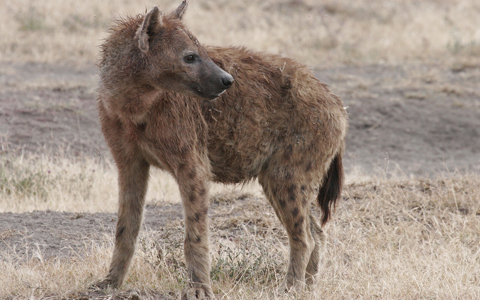
What Can We Do to Stop Deforestation?
You alone can make a tremendous impact on the future of our planet’s tree population. The following are ways that you can help stop deforestation:
Plant a Tree – Every tree you plant slows down the effects of deforestation. However, planting a tree isn’t enough. It is just as important to keep that tree healthy and resistant to disease and insect infestation.
Adding to the complexity of this situation is the process of natural deforestation. This is when beetles and other boring insects successfully attack large numbers of trees in either urban settings or forests. As these trees die, they dry out and become fuel for wildfires.
Besides annual inspections of your trees, whenever you detect the presence of an infestation or disease, call an arborist to assess the situation and offer a course of action.
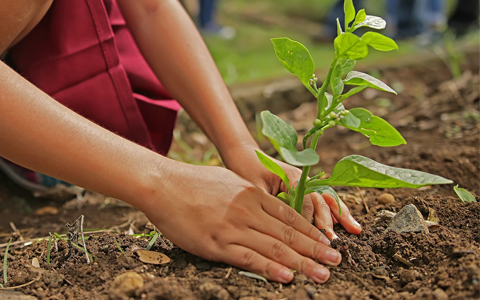
you can discover more about tree health problems and solutions by visiting 72tree.com/9-common-tree-health-problems-solutions/
Go Paperless – Whenever possible, receive and pay bills online. With the technological advances we have at our fingertips, we are able to reduce the use of nearly all paper products drastically.
Recycle – For decades, companies and households of all sizes have been recycling. You can push this concept forward by only purchasing recycled paper products and by recycling yourself.
Look for Forest Stewardship Council Certification – This is known as FSC certification and can be found on wood, paper, and food products. Products with this certification are produced in sustainable ways and can be classified as follows:
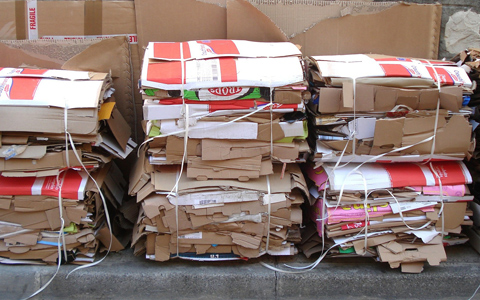
• FSC 100% includes products that come from FSC-certified forests.
• FSC Recycled means the wood or paper within a product is sourced from reclaimed material.
• FSC Mixed means at least 70 percent of the wood in a product comes from FSC-certified or recycled material, and that 30 percent is made of controlled wood.
Eat Vegetarian – By eating vegetarian or vegan meals as often as possible, you are reducing the demand for livestock, thereby reducing the need for deforestation to graze the animals.
Teach Others about Sustainability – The most impactful thing you can do to save our trees and forests is to teach others how to live sustainably.
According to recent research, nearly half of the world’s trees have been lost over the past 12,000 years to agriculture and population growth, and at the rate trees are currently being cut down, they will be gone in 200 years unless we take action to prevent it.
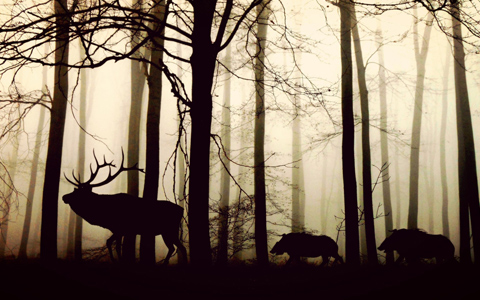
What Can We Do to Save Trees
As mentioned above, planting a tree helps turn back the effects of deforestation, while saving trees is a bit different. To save a tree, you don’t necessarily need to travel to the forest and stand in the way of a bulldozer.
You can save trees every day by caring for the ones that surround you:
• Plant trees in their hardiness zone.
• Plant trees in locations where they can grow freely.
• Adjust soil conditions to match your trees’ needs.
• Prune your trees as it grows.
• Water your trees during dry weather.
• Learn to identify signs of disease and infestation.
• Schedule annual inspections by an arborist.
• When a tree becomes a hazard, have it removed.
That last bullet point may have confused you. There are times when tree diseases or infestations can pose a grave threat to the surrounding ecosystem. In such cases, removing the tree may be the only practical option to protect other trees.
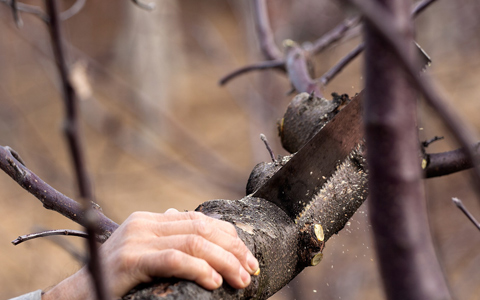
Cutting Down Trees Affects Us and Our Environment
All living creatures including mankind need trees to breathe, eat, and live. Life on earth, at all levels, depends on the abundant existence of a healthy tree population.
In this article, you discovered important tree population information, statistics, problems, and actions we can take to care for our trees and keep our planet habitable.
Ignoring that there is a problem only allows the problem to flourish. If we are to preserve our planet, each of us must take action in some way to keep our trees healthy and rely less on the material possessions that encourage deforestation.
Sources:
https://blogs.worldbank.org/opendata/five-forest-figures-international-day-forests
https://www.epa.gov
https://www.greenpeace.org/usa/forests/solutions-to-deforestation/
https://www.ucsusa.org/global-warming/solutions/stop-deforestation
https://ic.fsc.org/en/what-is-fsc-certification
https://www.nature.com/articles/nature14967
Notice: Undefined variable: page in /home/vrxdg1855sn3/public_html/wp-content/themes/72tree/content.php on line 15
Notice: Trying to get property 'ID' of non-object in /home/vrxdg1855sn3/public_html/wp-content/themes/72tree/content.php on line 15
Pomegranate Tree Information, Questions and Answers
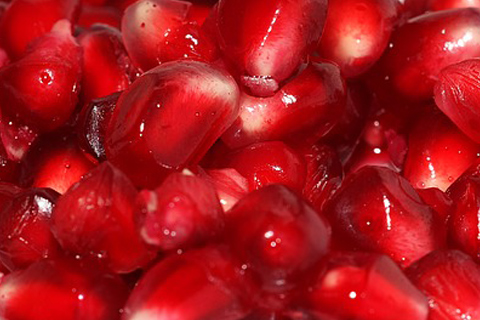
One of the healthiest fruits you can consume comes from the Punica granatum (pomegranate) tree. But how much do you really know about this amazing tree species?
Pomegranate trees produce the incredible pomegranate fruit and have been cultivated for several millennia. Relatively easy to care for, this tree, its flower, and fruit all have profound historical and cultural significance.
www.72tree.com gathered pomegranate tree information and history, care tips, and answers several frequently asked questions.
Pomegranate Tree Information
Pomegranate is a tree species native to the region of Iran to Afghanistan and Pakistan to Northern India. Today, the species is cultivated throughout the Middle East, Northern and Tropical Africa, Asia, the Mediterranean Basin, and parts of the Southwestern United States.
Tree Name – Pomegranate
Scientific Name/Species – Punica granatum
Family – Lythraceae
Genus – Punica
Nickname – Winter Jewels, Red Ruby, and Chinese Apple
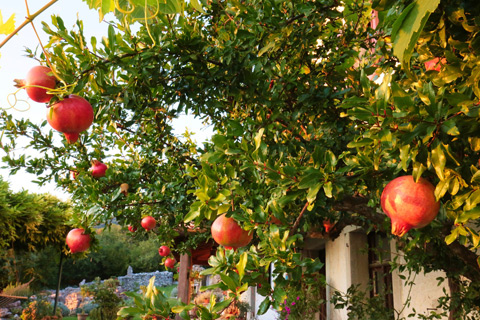
Lifespan – Can live up to 200 years or more when planted in optimal conditions.
Type – Deciduous.
Hardiness Zone(s) – from 8a to 13a
Soil Requirements – Versatile, prefers well-drained rich, fertile soil with full sun exposure.
Planting Spacing – 5 to 6ft
Watering Requirements – Regular when young or planted. Minimal thereafter.
Height – 15ft on average. Can reach 30ft under optimal conditions.
DBH – NA
Crown Span – 8 to 10ft or more at maturity.
Root Spread – Wide and shallow (10-25ft from the trunk and 2 to 3ft deep)
Uses in Landscaping – Highlight tree, border or division, and addition to orchards.
Winter/Fall Colors – Yellow before leaf-drop in the fall.
Pests – Healthy pomegranates are incredibly resilient to insect attacks but may see aphids, whiteflies, mealybugs, and thrips in the spring and summer months. Neem oil or other organic insecticides can be used to control them easily.
Disease – Keeping your pomegranate tree healthy will help it avoid or fight rot, anthracnose, and fungal wilt.
Major Disease Threat – Heart Rot
Pomegranate Origin and History
Originating from Iran to the Himalayas in northern India, Punica granatum (pomegranate) has been grown for several millennia, and was cultivated and naturalized over the extent of the Mediterranean region.
It wasn’t until 1769 that Spanish settlers introduced the first pomegranate specimen to California. Two and a half centuries later, pomegranate trees can be found throughout the US in a commercial capacity as well as in private landscapes and potted in our homes.
Armenian culture sees the pomegranate as a semi-religious icon. A symbol representing abundance, marriage, and fertility, the fruit and its juice are used with Armenian food, heritage, and wine.

As the fruit contains numerous seeds, it is perceived to symbolize fruitfulness. Thus, fostering the tradition to eat the fruit on Rosh Hashana. Besides several mentions in the Bible, some believe the fruit has 613 seeds corresponding to the 613 commandments found in the Torah.
Care Tips for Pomegranate Trees
Pomegranate trees do not require much attention. They are very adaptable to their environment and remarkably resilient to infestation and illness when healthy.
The following tips will assist you in keeping your pomegranate tree(s) healthy and thriving.
Planting Location and Soil – Pomegranates will adapt to nearly any well-drained soil condition regardless of its pH. As long as your specimen receives full sun and is protected from temperatures below 40 degrees Fahrenheit, it should thrive.
Watering – Pomegranate roots grow within the first 2 to 3 feet of soil and do not require deep watering. Keep the soil moist for the first 8 months to 1 year, and again when the tree is bearing fruit.
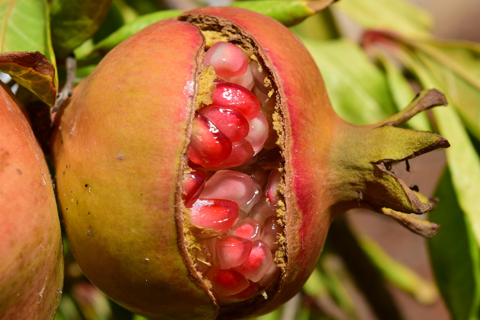
Once the tree’s roots are established, you can cut back to 2 waterings per month in the drier months. By this time though, your tree will be able to tolerate drought conditions.
When the tree is bearing fruit, you can prevent the fruit from splitting by keeping the soil moist.
Fertilizer – After planting a pomegranate tree, you do not need to fertilize it for a full year. The use of organic mulch (manure or compost) will suffice.
Thereafter, each spring, you can apply 2 ounces of nitrogen granules. Increase the dose 1 ounce for each subsequent year.
There are fertilizers specially formulated for fruit trees which may be used as well.
Pruning – Pomegranate trees produce flowers on new growth and can be pruned to remove damaged or dying branches, to shape the tree, or to remove suckers, dead wood, and unwanted growth.
The best time to prune your tree is late winter or early spring before the buds break, and when the threat of frost has subsided.
Be cautious of over-pruning, as it will reduce the amount of fruit your tree is able to produce.
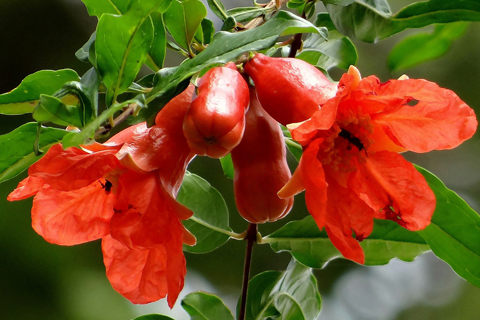
Frequently Asked Questions
Question: Do All Pomegranates Have 613 Seeds?
Answer: No. While some will debate that all pomegranates have this number of seeds, it would be quite easy to prove the contrary.
Question: What Are Pomegranate Seeds Called?
Answer: Arils.
Question: Are Pomegranates Anti-Inflammatory?
Answer: Studies show that pomegranates have excellent anti-inflammatory properties.
Question: What Vitamins Are in Pomegranate Seeds?
Answer: Pomegranates have B vitamins including folate, vitamin C, vitamin K, and potassium.
Question: Are Pomegranates an Antioxidant?
Answer: They have high contents of polyphenols and are renowned for their antioxidant capabilities.
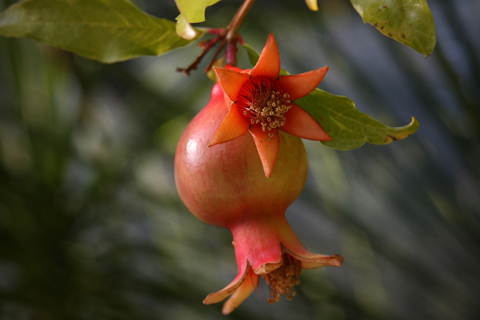
Question: How Long Does It Take for Pomegranate to Fruit?
Answer: Pomegranate trees can take up to 7 months for their fruit to fully mature. The tree itself will only bear fruit after two to three years of hearty growth.
Question: When Do Pomegranate Fruits Ripen?
Answer: Pomegranate fruit in the northern hemisphere typically ripens from September to February, and from March to May in the southern hemisphere.
Pomegranate Trees and Fruit for Your Landscape and Health
Cultivated for thousands of years, the pomegranate tree and its fruit have been gracing landscapes and providing powerful antioxidants through vitamin-rich seeds for generation after generation.
In this article, you discovered the history of the pomegranate tree, how to care for them, and the answers to many common questions about the species.
Growing a pomegranate tree is easy when compared to other fruit trees, and should be a part of your landscape. With a little patience and care, you could have ripening pomegranates in under three years.
Sources:
https://www.science.gov/topicpages/t/total+pomegranate+tannin
https://www.crfg.org/pubs/ff/pomegranate.html
https://hgic.clemson.edu/factsheet/pomegranate/
Notice: Undefined variable: page in /home/vrxdg1855sn3/public_html/wp-content/themes/72tree/content.php on line 15
Notice: Trying to get property 'ID' of non-object in /home/vrxdg1855sn3/public_html/wp-content/themes/72tree/content.php on line 15
Preventing and Eliminating Christmas Tree Bugs
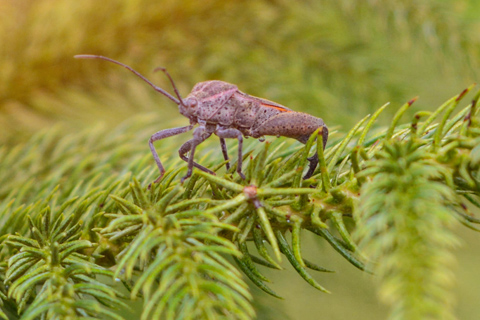
The Christmas tree is the pinnacle of holiday decorating but can also be a nightmare when bugs hitch a ride on the tree into your home.
Infested Christmas trees present a series of problems for the homes and neighborhoods they decorate. Pest control and prevention are essential measures when putting up a live tree for the holidays.
72tree.com collected information on the bugs that can be found on Christmas trees, how to prevent the buying of an infested tree, eliminating any insects found on the tree, and how to properly dispose of the tree.
Bugs on Christmas Trees
When you go to your local Christmas tree lot, keep in mind that just a few days prior, those trees were cut down from a Christmas tree farm or a forest.
Insects may have nested in or laid eggs on these trees. The following are some of the insect species you may encounter living or hatching in your Christmas tree:
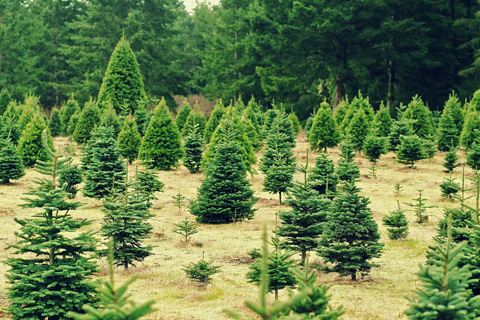
• Aphids
• Spiders
• Bark Beetles
• Mites
• Scale
• Needle Scale
• Mantises
• Spotted Lanternflies
• Sawfly
• Adelgids
• Stink Bugs
Note: Store-bought wreaths and swags made from live tree stems may travel thousands of miles from where they originated (potentially exposing your ecosystem to a new or invasive insect species). During the manufacturing and packing processes, bugs and the eggs they lay can easily be overlooked.
How To Prevent Bugs on your Christmas Tree
You can prevent bringing bugs into your home on a Christmas tree by following a few easy steps:
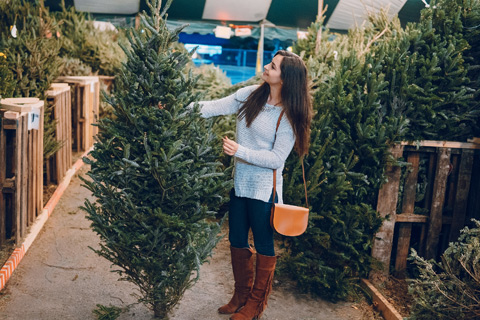
Right Time to Shop – Do not shop for a Christmas tree at night. It is easier to spot insects and eggs during the daytime.
Inspect the Under Side of Branches – Lay the tree down and get an up-close look at the underside of the branches and the trunk. Pay particular attention to the lower branches. You are looking for:
• Visible Insects
• Red or Brown Dots (Mites)
• Clusters of Eggs (Mantises and Lanternflies)
• What Appear to Be Snowflakes (Adelgids)
• White or Red Dots on Needles (Scale)
• Brown Cocoons (Sawfly)
• Small Holes in Trunk (Bark Beetle)
• Sawdust Trails (Bark Beetle)
Let It Stand – Attach the base and let the tree stand in the garage for a day or two. As a preventative measure, apply neem oil or insecticidal soap to the tree before moving it inside and decorating it.
How To Get Rid of Christmas Tree Insects
One of the most common insects found on Christmas trees is aphids. Killing aphids and other insects can be accomplished by spraying the tree with non-toxic neem oil or a homemade insecticidal soaps. Read more about killing aphids.
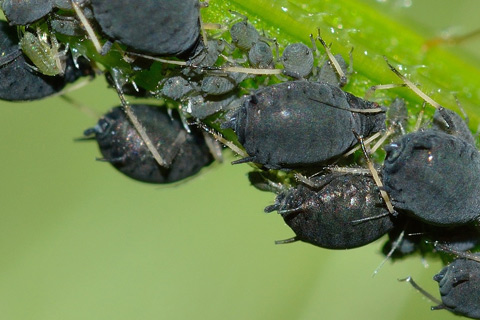
For the most part, newly hatched insects and spiders quickly expire from desiccation (they dry out). However, there are those that do survive.
Beetles, mantises, spotted lanternflies, and sawflies can leave the tree and potentially make their way outside. Again, the application of neem oil and insecticidal soap can be used to control these insects.
If you spot insects or eggs on your tree, DO NOT use commercial aerosol bug sprays. There is no necessity to expose yourself and your loved ones to these harsh chemicals. And, as many of them are flammable, you risk having the tree and your home go up in flames.
For pests that have fallen to the floor or are on your furniture, avoid stepping on them or crushing them (they can leave stains, and some insects have a putrid smell).
Use a vacuum cleaner that doesn’t have a beater bar to suck them up. Then treat the bag or the receptacle with neem oil or insecticidal soap before disposing of them.
How To Dispose of a Christmas Tree
To help preserve the ecosystem in your region, avoid placing the used tree on brush piles or compost heaps. Invasive insects and diseases are able to escape into landscapes and neighboring forests, becoming established, and upsetting the native ecosystem.
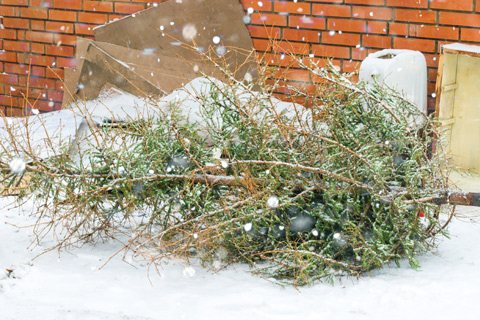
When you take steps to properly purchase, treat, and dispose of a Christmas tree, these risks are dramatically reduced.
Many municipalities and counties nationwide have pickup programs established to retrieve your tree at curbside and properly dispose of it.
If you miss this service or it isn’t available, you can take the tree to a solid waste facility, dump, or landfill. This will keep any pests that may remain in the tree from spreading.
Bug-Free Christmas Tree for the Holiday Season
An infested Christmas tree inside your home probably wasn’t on your wish-list for this holiday season. When bugs hitch a ride into your home, you need to know how to handle them efficiently.
From this article, you have discovered which bugs can be found on a Christmas tree, what to look for when purchasing the tree, how to eliminate any bugs on the tree, and how to properly dispose of the tree once the season is over.
Your home, neighborhood, and neighboring forest are all at risk when the poor management of a Christmas tree infestation allows foreign or invasive insects to disrupt a native ecosystem. Pest control and prevention should be one of the main concerns of a live tree in your home for the holidays.
Sources:
https://hortnews.extension.iastate.edu/insects-christmas-trees
https://christmastrees.ces.ncsu.edu/badbugs/
https://extension.unh.edu/resources/files/resource000986_rep2299.pdf
https://aces.nmsu.edu/ces/yard/2000/122300.html
Notice: Undefined variable: page in /home/vrxdg1855sn3/public_html/wp-content/themes/72tree/content.php on line 15
Notice: Trying to get property 'ID' of non-object in /home/vrxdg1855sn3/public_html/wp-content/themes/72tree/content.php on line 15
Killing Aphids
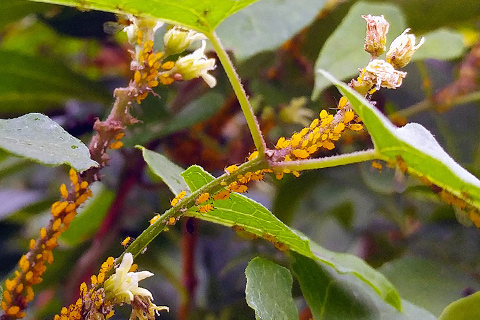
Disgusting aphids are a severe problem that can destroy your landscape. During an infestation, what appears to be a black tar on your foliage is actually a fungus growing in aphid excrement. The more of this you see, the bigger your problem is.
Aphids can cause the eventual death of your plants and trees, both indoors and outdoors. Upon detection of an infestation, treatment should begin immediately, and only end when all signs of the pest are gone.
In this article, 72tree.com answers some common aphid questions, and offers three easy methods to control them.
How to Get Rid of Aphids
Getting rid of your aphid problem starts with observing how big of a problem you have, determining which actions to take, and following up to ensure the problem is over.
Observation – In many aphid infestations, you may notice the presence of ants. These ants are not attacking the aphids, they are cultivating the honeydew excrement which they produce.
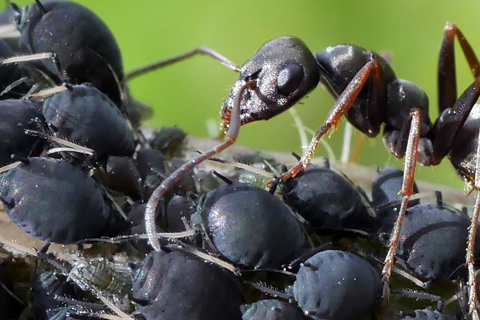
If this is the case, locate the ant trail(s) and treat the ant problem simultaneously with the aphid problem. You will see below that these three treatments work well for both insects.
Action – The following are 3 simple solutions that eliminate aphids without the use of commercial insecticides.
1 – Insecticidal Soap – The ingredients are:
• Liquid dishwashing soap (Dawn, Ivory, etc. but not the special formula varieties)
• Vegetable oil (corn, canola, sunflower, etc.)
• Warm water (filtered or soft water)
Step 1 – Mix 1/2 cup of vegetable oil with 3 Tbsp of dishwashing soap in a measuring cup and mix well.
Step 2 – Pour the mix into an empty (clean) gallon container and fill it halfway with warm water.
Step 3 – Shake the mixture well and fill a spray bottle with it. Keep the remainder of the mixture in a cool, dry place until the next use.
Application – In the early morning or late afternoon, spray the mixture directly on the aphids and ants (if present), you will also spray the area around the infestation, and along the ant trails.
Apply the mixture weekly in the same way for three weeks, or until the pests are eliminated.
2 – Neem Oil – Neem oil is a pungent vegetable oil derived from the fruit and seeds of an evergreen tree called Neem.
Pure Neem oil can be purchased at your local gardening center and comes ready for use.
Application – Again, in the early morning or late afternoon, spray the oil directly on the aphids and surrounding areas.
When sprayed along ant trails, Neem oil is very effective in repelling many species of ants. This is accomplished by disrupting the pheromone trails ants leave for others to follow.
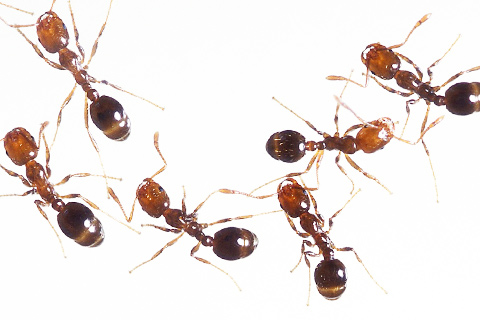
Apply on a weekly basis until the ants and aphids are no longer visible.
3 – Vinegar Spray – The ingredients are:
• Vinegar (white or apple cider)
• Water
Step 1 – Mix equal parts of vinegar and water together in a spray bottle.
Application – In the early morning or late afternoon, spray the water and vinegar mixture directly on the infestation and surrounding area.
When sprayed in the affected area and along the ant trail, this solution works well to repel the ants and disrupt their pheromone trail.
Apply weekly until the infestation has been eliminated.
For treating other insect infestations, visit this link https://www.72tree.com/using-dormant-horticultural-oil-treat-tree-insect-infestations/
People Also Ask
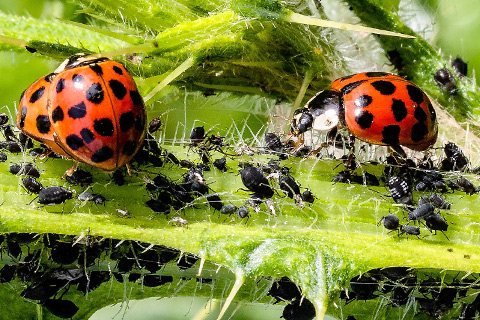
Q: Why Do You Apply Insecticides in the Morning?
A: Insecticides and insect deterrents are applied in the early morning or late afternoon to avoid overheating the foliage in direct sunlight.
Q: How Long is the Life of an Aphid?
A: Depending on the species and environment, aphids live from one week to forty days.
Q: How Long Do Aphid Infestations Last?
A: As aphids are able to reproduce rapidly, infestations can occur relatively quickly and may last until the death of the host (without treatment).
Q: What Insects Eat Aphids?
A: The most beneficial predatory insect of aphids is the ladybug. Plant marigolds, sunflowers, dill, and daisies to attract ladybugs, lacewings, and other beneficial insects. Also, consider buying and releasing ladybugs directly into your garden.
Q: Do Ants Eat Aphids?
A: No – Ants cultivate and eat aphid excrement (called honeydew) which is produced after the aphids consume the sap from plant and tree foliage.
Q: What Is the Black Film All Over the Leaves?
A: During an aphid infestation, the black tar-like substance on the foliage is actually a fungus known as “sooty mold” growing in the honeydew (aphid excrement).
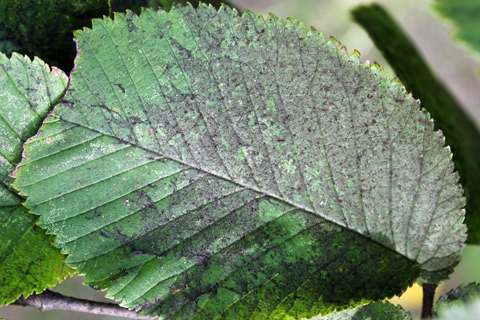
Keep Your Landscape and Home Aphid Free
With the ability to quickly multiply and infest your landscape, aphids can cause the decline and eventual death of your plants and trees.
In this article, we’ve answered common “aphid” questions, you’ve learned to identify an aphid infestation and take action. You now know how to use three effective control methods and how to attract beneficial insects to your landscape.
By not taking action against an aphid infestation, you are leaving your plants and trees vulnerable to other insect infestations and disease which can kill them even faster.
Sources:
https://www.pestworld.org/news-hub/pest-articles/six-steps-to-an-ant-free-home/
